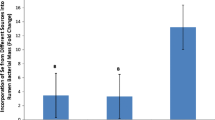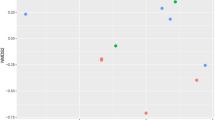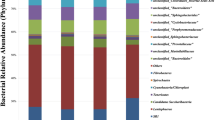Abstract
The effects of selenium (Se) on ruminant microbial fermentation were investigated in vitro using rumen microflora collected from a rumen-fistulated dairy cow. First, the effects ofl-selenomethionine (SeMet; at 0.2 or 2 ppm Se) in the presence or absence of wheat bran (WB, 500 mg per incubation flask) were evaluated. Second, the effects of several forms of Se (elemental Se: 50 ppm Se; sodium selenite: 2 ppm Se; SeMet: 2 ppm Se) were compared. Results showed that the amounts of short-chain fatty acids (SCFAs) tended to be increased by SeMet treatment, whereas SeMet in the presence of WB transiently suppressed fermentation. The addition of SeMet tended to increase the production of acetate while reducing the production of butyrate with and without WB supplementation. Among the different Se compounds tested, the amounts of SCFAs were greater with SeMet treatment, which yielded a higher proportion of acetate compared to other treatments. Selenite did not influence the total SCFAs concentrations; however, it increased the relative proportion of butyrate at the expense of acetate. Elemental Se did not significantly affect fermentation. Higher bacterial Se concentrations were observed for selenite than for SeMet. It was concluded that Se supplementation can influence rumen microbial fermentation and that Se compounds differ in this regard.
Similar content being viewed by others
References
E. Randall, J. R. Marshall, J. Brasure, and S. Graham, Dietary patterns and colon cancer in Western New York,Nutr. Cancer 18, 265–276 (1992).
J. D. Potter, Colon cancer—Do the nutritional epidemiology, the gut physiology and the molecular biology tell the same story?J. Nutr. 123, 418–423 (1993).
R. J. Shamberger, S. A. Tytko, and C. E. Willis, Antioxidant and cancer. Part VI. Selenium and age-adjusted human cancer mortality,Arch. Environ. Health 31, 231–235 (1976).
W. C. Willet, B. F. Polk, J. S. Morris, M. J. Stampfer, S. Pressel, B. Rosner, J. O. Taylor, K. Schneider, and C. G. Hames, Prediagnostic serum selenium and risk of cancer,Lancet 2, 130–133 (1983).
L. C. Clarke, G. F. Combs Jr., L. Hixson, D. R. Deal, J. Moore, J. S. Rice, M. Dellasega, A. Rogers, and J. Woodaro, Low plasma selenium predicts the prevalence of colorectal adenomatous polyps in a cancer prevention trial,FASEB J. 7, 3, 4 A65 (1993).
D. F. Birt, Inhibition by dietary selenium of colon cancer induced in the rat by bis(2-oxopropyl) nitrosamine,Cancer Res. 42, 4455–4459 (1982).
M. Jacobs, Selenium inhibition of 1,2-dimethylhydrazine-induced colon carcinogenesis,Cancer Res. 43, 1646–1649 (1983).
B. S. Reddy, S. Sugie, H. Maruyama, and P. Marra, Effect of dietary excess of inorganic selenium during initiation & post-initiation phases of colon carcinogenesis in F344 rats,Cancer Res. 48, 1777–1780 (1988).
J. P. Langlands, J. E. Bowles, G. E. Donald, and A. J. Smith, Selenium excretion in sheep,Aust. J. Agric. Res. 37, 201–209 (1986).
M. Hidiroglou and J. R. Lessard, The effect of selenium or vitamin E supplementation on volatile fatty acid content of rumen liquor in sheep fed a purified diet,Int. J. Vit. Nutr. Res. 46, 458–463 (1976).
T. Sakata and H. Tamate, Rumen epithelial cell proliferation accelerated by rapid increase in intraluminal butyrate,J. Dairy Sci. 61, 1109–1117 (1978).
G. F. Combs, Jr. and S. Combs, The biologic availability of selenium in foods and feeds, Chapter 4, inThe Role of Selenium in Nutrition, Academic New York, pp. 127–178 (1986).
A. B. Serra, K. Nakamura, T. Matsui, T. Harumoto, and T. Fujihara, Inorganic selenium for sheep, I. selenium balance and selenium levels in the different ruminal fluid fractions,Asian-Australasian J. Anim. Sci. 7, 83–89 (1994).
J. B. J. Van Ryssen, J. T. Deagen, M. A. Beilstein, and P. D. Whanger, Comparative metabolism of organic and inorganic selenium by sheep,J. Agric. Food Chem. 37, 1358–1363 (1989).
H. K. Goering and P. J. Van Soest, Forage Fiber Analyses.Agriculture Handbook, No. 379, Agricultural research service, USDA (1970).
G. A. Weaver, J. A. Krause, T. L. Miller, and M. J. Wolin, Constancy of glucose and starch fermentations by two different human faecal microbial communities,Gut 30, 19–25 (1989).
N. L. Whitehouse, V. M. Olson, C. G. Schwab, W. R. Chesbro, K. D. Cummingham, and T. Lykos, Improved techniques for dissociating particle-associated mixed rumen microorganism from rumen digesta solids,J. Animal Sci. 72, 1335–1343 (1994).
O. E. Olson, Fluorometric analysis of selenium in plants,J. Assoc. Offoc. Ana. Chem. 52, 627–634 (1969).
G. A. Spiller, M. C. Chernoff, R. A. Hill, J. E. Gates, J. J. Nassar, and E. A. Shipley, Effect of purified cellulose, pectin, and a low-residue diet on fecal volatile fatty acids, transit time and fecal weight in humans,Am. J. Clin. Nutr. 33, 754–759 (1980).
F. R. Ehle, J. B. Robertson, and P. J. Van Soest, Fiber fermentation in human large intestine,J. Nutr. 112, 158–166 (1982).
P. J. Van Soest,Nutritional Ecology of the Ruminant, 2nd ed., Cornell University Press, Ithaca, NY (1994).
G. T. Macfarlane, G. R. Gibson, E. Beatty, and J. H. Cummings, Estimation of shortchain fatty production from protein by human intestinal bacteria on branched-chain fatty acid measurements,FEMS Microbiol. Ecol. 101, 81–88 (1992).
M. Hidiroglou, D. P. Heaney, and K. J. Jenkins, Metabolism of inorganic selenium in rumen bacteria,Can. J. Physiol. Pharmacol. 46, 229–234 (1968).
P. D. Whanger, P. H. Weswig, and J. E. Oldfield, Selenium, sulfur and nitrogen levels in ovine rumen microorganisms,J. Anim. Sci. 46, 515–519 (1978).
R. J. Shamberger, Comparative metabolism and biochemistry of selenium and sulfur, inBiochemistry of Selenium, R. J. Shamberger, ed., Plenum, New York, pp. 82–99 (1983).
G. T. MacFarlane and J. H. Cummings, The colonic fermentation and large bowel digestive function, inThe Large Intestine Physiology, Pathophysiology and Disease, S. F. Phillips, J. H. Pemberton, and R. G. Shorter, eds., Raven, New York, pp. 51–92 (1991).
W. Scheppach, F. Wehner, P. Bartram, P. Schramel, and H. Kasper, Metabolic and nutritional parameters in patients after colonic polypectomy,Digestion 41, 94–100 (1988).
Author information
Authors and Affiliations
Rights and permissions
About this article
Cite this article
Kim, J., Van Soest, P.J. & Combs, G.F. Studies on the effects of selenium on rumen microbial fermentation in vitro. Biol Trace Elem Res 56, 203–213 (1997). https://doi.org/10.1007/BF02785393
Received:
Accepted:
Issue Date:
DOI: https://doi.org/10.1007/BF02785393




